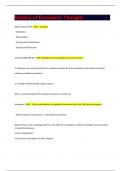Exam (elaborations)
History of Economic Thought
- Course
- Institution
Before Adam Smith - ANS - Aristotle - Scholastics - Mercentilism - Pre-classicist: David Hume - Quesnay & Physiocrats Aristotle (384-322 BC) - ANS Examples of reasoning about economic issues: 1. Exchange can only come if there is a potential surplus from the transaction that parties can share...
[Show more]



